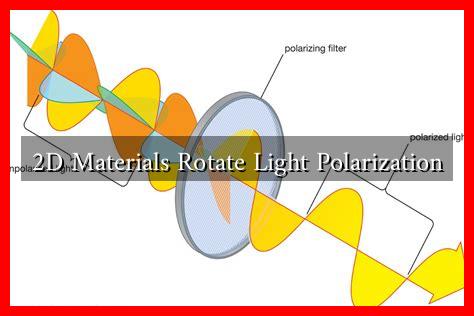-
Table of Contents
2D Materials Rotate Light Polarization
Two-dimensional (2D) materials have been at the forefront of scientific research due to their unique properties and potential applications in various fields. One fascinating property of 2D materials is their ability to rotate the polarization of light, which has opened up new possibilities in optics and photonics. In this article, we will explore how 2D materials interact with light and the implications of their ability to rotate light polarization.
Understanding Light Polarization
Light is an electromagnetic wave that oscillates in a specific direction as it travels through space. The direction of this oscillation is known as the polarization of light. When light interacts with a material, its polarization can be altered depending on the properties of the material.
2D Materials and Light Polarization
2D materials, such as graphene, transition metal dichalcogenides (TMDs), and black phosphorus, have been found to exhibit unique optical properties due to their atomically thin structure.
. These materials can interact with light in ways that are not possible with traditional bulk materials.
Graphene
Graphene, a single layer of carbon atoms arranged in a hexagonal lattice, is known for its exceptional electronic and optical properties. When light passes through graphene, it can induce a phenomenon known as the Faraday effect, where the polarization of light is rotated in response to an external magnetic field.
Transition Metal Dichalcogenides (TMDs)
TMDs, such as molybdenum disulfide (MoS2) and tungsten diselenide (WSe2), are another class of 2D materials that exhibit strong light-matter interactions. These materials can also rotate the polarization of light, making them promising candidates for applications in optoelectronics and quantum technologies.
Applications of Light Polarization Rotation
The ability of 2D materials to rotate the polarization of light has significant implications for various technological applications. Some of the key areas where this property can be leveraged include:
- Optical communication systems
- Polarization-sensitive imaging techniques
- Optical sensors and detectors
- Quantum information processing
Future Directions and Challenges
As researchers continue to explore the optical properties of 2D materials, new opportunities and challenges arise. Understanding the mechanisms behind light polarization rotation in these materials and optimizing their performance for practical applications are ongoing areas of research.
Conclusion
In conclusion, 2D materials have the remarkable ability to rotate the polarization of light, opening up new possibilities in optics and photonics. Graphene, TMDs, and other 2D materials exhibit unique optical properties that can be harnessed for a wide range of applications. By further exploring and harnessing the light-matter interactions in these materials, researchers can unlock the full potential of 2D materials in shaping the future of optical technologies.





